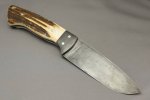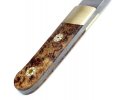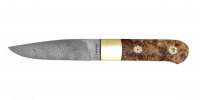Years ago at Batsons symposium Rob Hudson was demonstrating,I asked him how he did the flamed edges.Finger nail polish was his resist at that time,But he also added that he etched the whole knife after assembly (he used wood handles almost all the time).He said he wrapped tape around the handle and then sealed the ends of the tape with finger nail polish,now here is the kicker,he purposfully flamed the edge around the guard and butcap,this seales the edge and didnt let any leaks get into the seam between metal and handle material.Just thought I would pass that on as a idea to use if you can't get the seam sealed from leaks,just make a wavy edge on the steel and when done that part will shine and look like you did allot of extra work on the handle,plus no leaks...
Good Luck
Bruce




